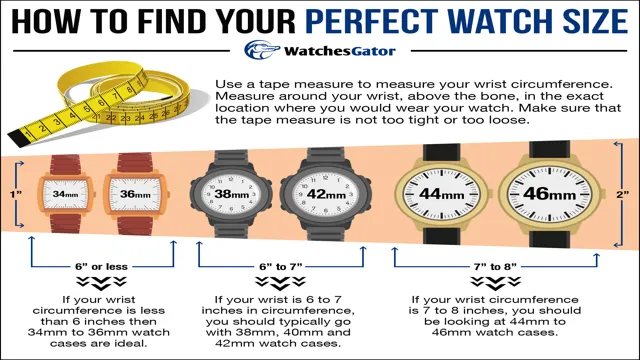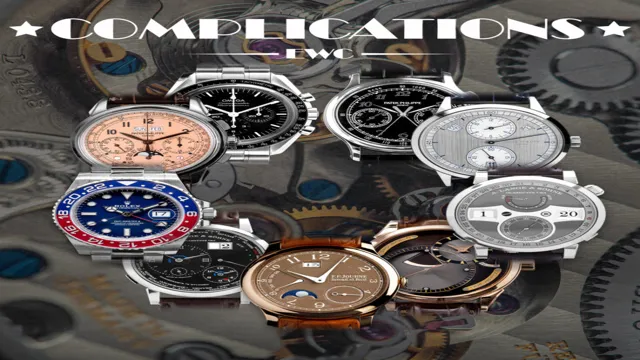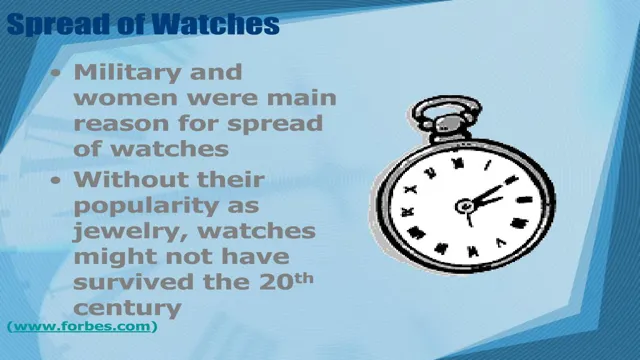Choosing the right watch size can make all the difference in how comfortable and stylish your wristwatch looks on you. With so many watch options in various sizes, it can be challenging to know which size best suits your wrist. Wearing the wrong-sized watch can quickly turn a swanky accessory into a bulky burden that can ruin any outfit.
You don’t want to spend money on a luxury watch only to find that it doesn’t fit your wrist correctly. In this blog post, we will discuss the importance of choosing the right watch size and provide helpful tips to help you make the right choice. So, if you are wondering what size watch is best for your wrist, keep reading!
7 Factors to Consider
Choosing the right size watch for your wrist can be daunting, especially with the many available options. However, several factors must be considered to help you find the perfect fit. Consider your wrist size; a large watch face can overwhelm a small wrist, whereas a small watch face may get lost on a larger wrist.
Secondly, think about the style of watch you want and how it will complement your outfit. Thirdly, consider the type of watch you want; a dress watch is usually smaller than a sports watch. Fourthly, think about the band material and how it will feel on your wrist, as well as the adjustability of the band.
Fifthly, think about the weight of the watch, and if it will be comfortable to wear for extended periods. Sixth, consider the overall watch design and whether it matches your taste and style. Lastly, consult a watch expert or try different sizes to ensure the perfect fit.
Considering these factors, you can confidently choose the right size watch for your wrist and enjoy your timepiece to the fullest.
Wrist size
When it comes to selecting the perfect wristwatch, the size of your wrist should be factored in. It’s essential to find a watch that complements your wrist size. Small wrists tend to look overwhelmed by larger timepieces, while a smaller watch on a large wrist can look like a child’s watch.
Here are some factors to consider when choosing a timepiece based on your wrist size. First, measure your wrist to determine its size and use that measurement as a guide when selecting watches. Consider the case diameter and thickness of the watch; a small watch should have a case diameter of about 38mm or less, and larger wrists can handle watches with diameters exceeding 42mm.
Pay attention to the lug-to-lug distance, which is the distance from lug to lug, to ensure that the watch sits nicely on your wrist. Additionally, watch straps or bands play a significant role, with larger wrists requiring wider straps of at least 22mm, while smaller wrists should consider using straps no more than 20mm wide. Lastly, a watch’s overall weight should be considered, not just its size; heavier watches may feel overwhelming on smaller wrists, whereas lighter watches may not sit well on larger wrists.
With these considerations in mind, finding the perfect watch just right for your wrist size is easier.

Case diameter
When it comes to selecting a watch, there are a number of important factors to consider. One such factor is the diameter of the watch case. The case diameter refers to the distance across the face of the watch from one edge to the other.
This measurement is typically expressed in millimetres. There are several things to remember when considering a watch’s case diameter. Firstly, the size of the watch should be appropriate for your wrist.
A large watch may look out of place and uncomfortable if you have a small wrist. Conversely, if you have a larger wrist, a small watch may look too delicate or even be difficult to read. Another factor to consider is the style of the watch.
Certain styles, such as chronographs, tend to have larger case diameters, while dress watches may be smaller. Ultimately, the size of the case diameter comes down to personal preference and what feels comfortable for the wearer.
Case thickness
When it comes to choosing a watch, one of the important factors to consider is the case thickness. This element affects not only the watch’s style but also its comfort level on your wrist. Here are seven factors to think about when selecting a watch based on its case thickness.
Firstly, the watch’s movement type can affect the case size, so be aware of this when checking specs. Secondly, a thicker case can provide additional water resistance, ideal for sport or diving watches. Thirdly, a slim wrist may look best with a thinner profile watch case.
Fourthly, the materials that the case is made of can affect its weight and thickness. Fifthly, consider the watch style and its overall design when selecting the case thickness. Sixthly, think about your personal style and wearing habits.
Finally, remember to check the watch’s dimensions and try it on your wrist to understand how it fits and feels. Considering these factors, you can select a watch with the right case thickness for your needs and style.
Bandwidth
Bandwidth is essential for anyone who relies on the internet, whether for downloading, streaming, or uploading data. When choosing bandwidth, there are multiple factors that you must consider to ensure that you get the best possible performance. First and foremost, the type of content you will be consuming or creating plays a crucial role.
For instance, high-resolution videos or online gaming require much greater bandwidth than basic web browsing. Additionally, your internet service provider’s (ISP) package and average speed must be considered, along with your geographical location and the time of day. The number of devices that will be connected to your network and their usage patterns are also important factors.
Lastly, your connection type, such as DSL, cable modem, or fiber-optic, can limit or enhance the bandwidth speed. Overall, it is important to evaluate all these factors to determine the optimum bandwidth needed in your particular situation.
Band material
When it comes to choosing the right band material for your watch, there are several factors to consider. First, consider your lifestyle and needs – are you typically active and need a more durable material, or do you mostly wear your watch for fashion? Second, think about your skin type and any allergies you may have. Leather bands are a classic choice but may not be suitable for those with allergies.
Third, consider the color and style of the watch face – a metal band may look sleek and modern, while a leather band can add a touch of elegance. Fourth, consider the band’s fit and adjustability – a metal mesh band can be adjustable to fit any wrist size, while a leather strap may require more holes for a perfect fit. Fifth, consider the maintenance and care needed for each type of band material – leather may require conditioning and cleaning, while metal may need polishing.
Sixth, keep in mind the cost and value for each type of material – leather may be more affordable, while gold or titanium may be more expensive. Last but not least, choose a band material that aligns with your personal style and preference. After all, your watch is a reflection of you!
Style and aesthetics
There are a few factors to consider when it comes to style and aesthetics. First and foremost, you want to think about the overall feeling you want to achieve. Do you want a modern, sleek look or something more rustic and homey? Next, think about colour schemes and patterns.
Mixing too many patterns can be overwhelming, so stick to one or two. Additionally, lighting can make a big difference in the overall ambience of a space. Don’t be afraid to play around with different types of lighting, from bright task lighting to soft, ambient lighting.
The texture is another important element to consider, whether it be through materials like wood and metal or through textiles like curtains and rugs. Lastly, don’t forget to add personal touches, like artwork and family photos, to really make a space your own. By considering and balancing these factors, you can create a stylish and aesthetically pleasing space that reflects your personal taste and personality.
Measuring Your Wrist
Choosing the right size watch for your wrist can be tricky, but it all starts with measuring your wrist. To measure your wrist correctly, wrap a tape measure around the widest part of your wrist and note down the measurement. Alternatively, you can use a piece of string or ribbon, mark where the end meets, and then measure the length with a ruler.
It’s essential to ensure that the tape or string isn’t too tight or too loose, as this can affect the accuracy of the measurement. Once you have the measurement, you can use it as a guide for choosing the right wrist-size watch. Typically, watches come in sizes ranging from 38mm to 48mm, and your wrist size will determine which size is suitable for you.
Remember, a watch that’s too large or small can make your wrist look awkward or uncomfortable. So, pick the right size watch that fits your wrist just right, and you’ll undoubtedly feel confident and stylish.
Using a tape measure
Measuring Your Wrist Using a Tape Measure Measuring your wrist correctly is essential when buying jewelry, watches, or anything else on your wrist. Using a tape measure is the easiest way to measure your wrist size. First, wrap the tape measure snugly around your wrist at the widest point, just below the wrist bone.
Make sure the tape measure is flat against your skin and not twisted. Press the end of the tape into the slot and read the measurement. This measurement is your wrist size, which is usually between 6 and 8 inches for most adults.
Keep in mind that watches and bracelets have different size options, so check the size guides before purchasing. And there you have it, with just a tape measure and a few simple steps, you now have the correct measurement of your wrist size!
Using a piece of string
When it comes to finding the perfect wrist accessory, the first thing you need to do is measure your wrist. Using a piece of string is a quick and easy way to measure accurately. First, wrap a piece of string around your wrist where you normally wear a bracelet or watch.
Make sure it’s snug but not too tight. Then, mark where the string meets and lay it flat against a ruler to get your wrist measurement. This will ensure that you get the right fit for your wrist accessory, which is important for both comfort and style.
So go ahead and grab that piece of string and start measuring!
Common Watch Sizing Mistakes to Avoid
Choosing the right sized watch for your wrist can be daunting for many people. One common mistake people make is selecting a watch that is too large or too small for their wrist. A watch that is too large will look bulky and overwhelming, while a watch that is too small will appear insignificant and be difficult to read.
To avoid these sizing mistakes, measuring your wrist accurately and choosing a watch size that complements your wrist size and shape is important. A good rule of thumb is to select a watch with a case diameter that is between 38-42mm for men and 34-38mm for women. It is also essential to consider the watch strap length and width to ensure a comfortable fit.
By selecting a watch size appropriate for your wrist, you can enjoy both the aesthetic and functional benefits of wearing a well-fitted timepiece that enhances your overall style.
Conclusion
Choosing the right size watch for your wrist is like picking the perfect pair of shoes – they need to fit just right and make you feel confident. Whether you have a dainty wrist or a larger one, the key is to find a watch with a case diameter that complements and accentuates your wrist, without overwhelming it. So, before you make your final decision, make sure to measure your wrist and consider your personal style.
Remember, a great watch is not just a functional accessory but a statement piece that reflects your unique personality and fashion sense. So choose wisely and wear it with confidence!”
FAQs
Why is choosing the right watch size important for comfortable wear?
Choosing the right watch size ensures that the watch sits comfortably on your wrist and doesn’t slide around, preventing discomfort and annoyance.
How do I measure my wrist size to choose the right watch?
To measure your wrist size, use a measuring tape or wrap a piece of string around your wrist, mark where it meets, and then measure the length. This measurement will help you choose the appropriate watch size.
Are there any visual cues that can help me choose the right watch size for my wrist?
Some visual cues that can help you choose the right watch size include considering your wrist shape and size and the watch face and strap width.
Can I wear a slightly larger or smaller watch than my wrist size?
It is generally recommended to pick a watch that’s comfortable and suits your style, but it’s also essential to ensure that it doesn’t look overwhelmingly large or small on your wrist. A watch that is too tight or loose may not sit well and not function as expected.



